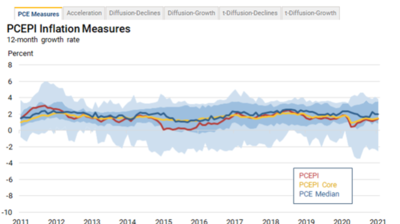Personal Consumption Expenditure (PCE)
The Personal Consumption Expenditure (PCE) measure is the component statistic for consumption in gross domestic product (GDP) collected by the United States Bureau of Economic Analysis (BEA). It consists of the actual and imputed expenditures of households and includes data pertaining to durable and non-durable goods and services. It is essentially a measure of goods and services targeted towards individuals and consumed by individuals.[1]
Collectively personal consumption expenditures are one of three main parts of the Personal Income and Outlays report. Personal income shows how much money consumers are bringing in. Personal consumption expenditures are a measure of the outlays or how much consumers are spending. The PCE Price Index uses the personal consumption expenditures component of the Personal Income and Outlays report to derive the PCE Price Index, which is the third major component of Personal Income and Outlays showing how prices are periodically inflating or deflating. Personal consumption expenditures are shown by the BEA in current dollars and chained dollars since 2012. Personal consumption expenditures form the basis for the reporting of the PCE Price Index, which is detailed both comprehensively using all categories of PCE and excluding food and energy, which is known as the Core PCE Price Index.
Like most economic breakdowns, personal consumption expenditures are split between goods and services. Goods can be broken out further into durable and nondurable goods. Each month the BEA reports the total value of personal consumption expenditures collectively and broken out by goods, durable goods, nondurable goods, and services. Durable goods are items that last a household for more than three years and typically carry a larger price tag. Examples of durable goods include cars, televisions, refrigerators, furniture, and other similar items. Non-durable goods are considered "transitory," meaning that their life expectancy is typically less than three years. These items are also typically less costly and include products like makeup, gasoline, and clothing. The BEA uses the current dollar value of personal consumption expenditures to calculate the PCE Price Index, which shows the amount of price inflation or deflation occurring from one period to the next (PCE inflation). Like most price indexes, the PCE Price Index must incorporate a deflator (the PCE deflator) and real values in order to determine the amount of periodic price change. Ultimately, the PCE Price Index and Core PCE Price Index excluding food and energy show how much the prices of personal consumption expenditures have changed from one period to another, but breakdowns of the PCE Price Index also show PCE inflation/deflation by category as well.[2]

source: FRBSF.org
- ↑ Definition of Personal Consumption Expenditure (PCE) Wikipedia
- ↑ Understanding Personal Consumption Expenditures (PCE) Investopedia
